What is a flywheel mushroom
Mushroom green moss or any other type of moss is a close relative of boletus, which grows in deciduous and coniferous forests. Most often it is found in moss, hence the name. There are about 18 species of this mushroom, almost all of them are edible, except for some false varieties.
- General description of the mushroom
- Where does the flywheel grow
- Edible species of mushrooms
- Flywheel green
- Flushing flywheel
- Fractured flywheel
- Flywheel brown
- Powdered flywheel
- Velvet mosswheel
- Swamp moss
- Conditionally edible mushrooms
- Semi-golden flywheel
- Parasitic flywheel
- Inedible flyworms
- Wood flywheel
- Pepper moss
- Summarizing
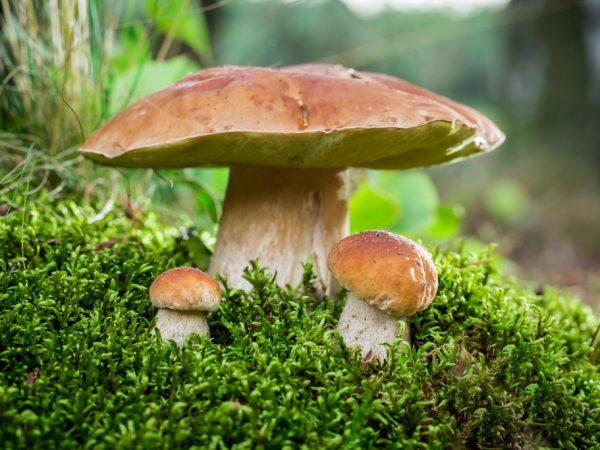
What is a flywheel mushroom
General description of the mushroom
What does a flywheel mushroom look like and how is it classified? This species belongs to the department Basidomycetes, the class Agaricomycetes, the order and family Boletovye, the genus Mokhovik (Xerocomus). In another way, it is called a goat mushroom, a sitovik, a fur coat.
The classification has changed slightly in recent years. Some species of Mokhoviks nevertheless belong to the Borovik genus by specialists due to the specific structure of the representatives of the Mokhovik genus (Xerocomus). Sometimes these mushrooms are called false mushrooms.
Like many edible species, the fruiting body consists of a cap (with a characteristic hymenophore) and a stem. The height reaches 3-11 cm.
Description of the fruiting body:
- Hat: its diameter is from 4 cm to 20 cm. The surface is dry and velvety, after rain it often becomes sticky. Color from dark green to brown. In young mushrooms, the cap is convex, in old ones it becomes flat, sometimes it becomes covered with cracks. The skin does not separate from the pulp.
- Hymenophore: tubular, the length of the tubules is about 2 cm. The color of the hymenophore is yellow, sometimes with green or brown tints.
- Disputes: have different shades of brown - from olive to dark brown.
- Pulp: dense, the middle in some cases resembles cotton wool in consistency. The shade of the pulp is yellow, yellow-green or red, turns blue on the cut.
- Leg: the shape is cylindrical, from below, thickened or narrowed, depending on the type. The surface is smooth, wrinkled, ribbed, sometimes covered with a fine black mesh, which is also associated with the species. The leg is always lighter than the cap. Diameter - from 0.5 cm to 2-4 cm.
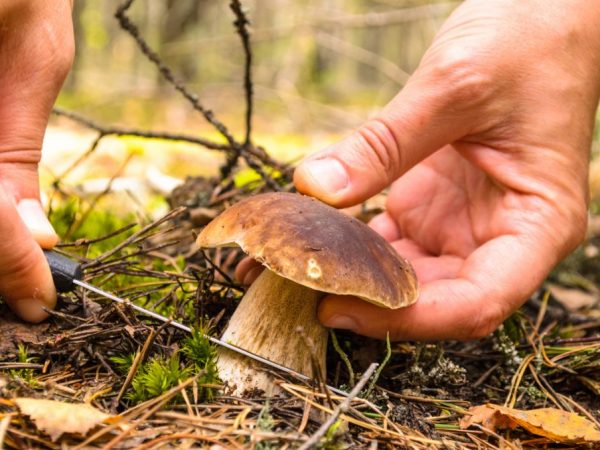
The flywheel consists of a cap with a hymenophore and a leg
The characteristic largely depends on the type of mushroom, although they are all similar to each other. When pressed, the color of the pulp changes to blue, because the tissue is damaged, as a result, a substance is released, which, upon contact with oxygen, acquires a blue tint. It protects the fruit body from further damage, does not affect its taste and safety in any way.
Where does the flywheel grow
Flywheels are found in different regions of the world. They grow in North America, Europe and European Russia, Asia, Australia and North Africa. Each part of the world has its own species. More varieties are found in temperate latitudes. But there are those who love the subtropics. So, for example, representatives of the species green flyworm grows in alpine meadows and even in the subarctic zone.
Flywheels are divided into groups by way of nutrition:
- mycorrhizal fungi: enter into symbiosis with different coniferous and deciduous tree species. Prefers spruce, hornbeam, beech, pine, linden, chestnut .;
- soil saprotrophs: live in forest glades or edges, old anthills, stumps and dead tree trunks;
- parasites: parasitic flywheel grows on the body of another fungus - pseudo-raincoat.
Mushrooms grow one by one, groups are rarely formed. The most favorable soil is sandy. Collection time starts in mid-May. Lasts until mid-October. In fruitful years, it is easy to collect a whole basket in a small area. Sometimes this group includes the Polish mushroom, but it belongs to a different genus.
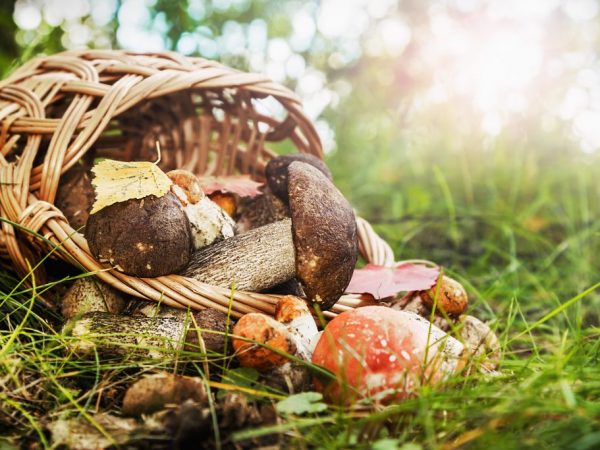
Flywheels grow one by one, groups are rarely formed
Edible species of mushrooms
The flywheel is usually an edible mushroom. In terms of its biochemical composition, it is inferior to porcini or boletus, but it is also considered tasty and valuable. It is readily collected, added to soups, gravies and other dishes. Freeze or pickle for the winter. In dried form, mushrooms are rarely stored: they turn black after this type of processing.
Flywheel green
Green moss is one of the most common species growing in temperate and northern climates. The appearance changes with age. Main signs:
- Hat: has a diameter of 4-11 cm. In young specimens it is semicircular, then becomes convex and cushion-shaped. Its surface is pubescent, velvety, cracked in dry weather.
- Pulp: oily, has a white or cream color, after breaking it acquires a faint blue tint.
- Hymenophore: tubular, sulfur-yellow in young mushrooms, then acquires a green or olive tint, in old fruiting bodies it becomes brown. When pressed, it turns blue slightly. The tubes are wide (this is a distinctive feature of this particular species), the shape is faceted or angular. In young mushrooms, the hymenophore grows together with the stem, then a notch is formed at the transition site.
- Disputes: elliptical or fusiform, olive brown.
- Leg: has the shape of a cylinder narrowed towards the bottom. Height - 4-11 cm, diameter - up to 2 cm. The top layer is hard, inside the pulp resembles cotton wool.
The taste is pleasant, delicate, with fruity notes. The mushroom is suitable for any kind of culinary processing, belongs to 2 categories. It is found in coniferous, deciduous and mixed forests, oak forests, is a mycorrhizal forming agent with coniferous and deciduous species.
Irina Selyutina (Biologist):
Due to its widest prevalence not only in Russia and Europe, but also in North America, Australia, Fr. Kalimantan, as well as the occurrence of the subarctic and subalpine zones, the green flyworm species received the status of a cosmopolitan mushroom.
The term "cosmopolitanism" comes from the ancient Greek words "space" - peace and "politis" - citizen. From the point of view of biology, cosmopolitanism means that a species, or other taxonomic unit, is found in most of the inhabited territories of the Earth (widespread). There are few known cosmopolitan species on our planet.
The harvesting season in Russia is from May to October.
Flushing flywheel
The blushing flywheel, or red, is a rare species. It is found in ravines, on the sides of old dirt roads. The main signs are:
- Hat: has a diameter of 10-14 cm. At first it is convex, then it becomes prostrate, sometimes with dents and a raised edge. The surface in young specimens is velvety, in old ones it is scaly, with cracks. Shades - red, wine red, burgundy, brown. Hence the name - "red flywheel". The skin adheres tightly to the pulp, does not come off. By the way. On the edge, the cap can be painted yellowish
- Hymenophore: the tubular layer of a young mushroom is golden yellow, with age, an olive tint appears. When pressed, it slowly changes color - turns blue. Near the stem, the tubules are denser than on the periphery.
- Pulp: dense, yellow (it has a reddish tint directly under the cap), slightly blue when cut.
- Leg: cylindrical, up to 10 cm in height, up to 10-15 mm in diameter. Closer to the cap, it is painted yellow, below it is brown or pink, covered with scales. The flesh of the leg is dense and solid.
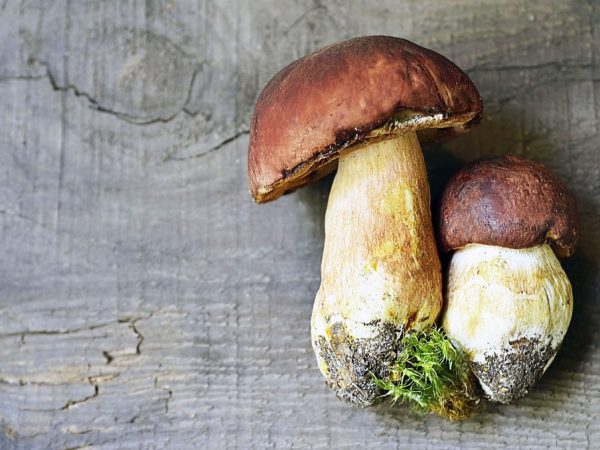
Red flywheels are found in ravines, on the sides of old dirt roads.
The red flywheel belongs to category 4. Mushrooms are delicious, suitable for any kind of culinary processing. They are harvested in late summer and early autumn (August and September). In appearance, this mushroom is a bit like Polish, but has more pronounced red tones in the color of the cap and legs. Representatives of the species are found in deciduous forests, especially in oak forests among moss or low grass. Since abundant fruiting has not been identified for the species, mushrooms are collected along the way with others.
Fractured flywheel
Fissured moss fungus, or variegated, grows in any coniferous and deciduous forests. It is not found only in mountainous areas and on peat soils.
Description of the variety:
- Hat: has a diameter of up to 10 cm, its color is light brown, brown, olive or gray-brown, reddish in the cracks. The edge is sometimes tinged with a purple hue. The surface is felt, with numerous cracks. The shape is cushion-shaped, the upper skin cannot be removed. By the way. The cracked surface of the cap is a characteristic feature of the species.
- Hymenophore: the young mushroom is yellow, turns green with age. The tubules are widened, angular, and descend to the stem. When pressed, the layer turns blue.
- Disputes: yellowish-olive or yellow-olive-brown hue.
- Pulp: loose, light yellow, reddish just under the skin and near the stalk. On the cut, it first turns blue and then turns red.
- Leg: tapers downwards, average height - 3-5 cm, maximum - 9 cm. Thickness - 10-15 mm, color light yellow, olive, in the lower part - red. If you press the pulp, it turns blue.
The variegated or fissured flywheel is harvested from July to October. It is tasty, but old fruiting bodies quickly deteriorate. Suitable for frying, pickling, rarely dried.
Flywheel brown
Brown or chestnut moss is a widespread species that is found in mixed forests (less often in conifers). Grows next to spruce, birch, beech. The area is the European part of Russia, Belarus, Poland, the north of Ukraine. In appearance, it resembles a little species of green moss and m. Variegated.
Its description:
- Hat: has a size of 6-10 cm. In youth it is hemispherical, then straightens. The color is brown, brownish red, olive brown. It gets dark when it rains. A white bloom forms on it, which is capable of transferring to other types of mushrooms. In dry weather, the cap cracks.
- Pulp: white or cream shade, does not turn blue on the cut. In young specimens it is dense, in old it becomes spongy.
- Hymenophore: with large pores, the length of the tubes is about 10 mm. Color - light yellow, does not change when pressed. The consistency at the beginning of the life of the fruiting body is dense, then the tubular layer becomes soft.
- The leg is often curved, growing 8-10 cm in length. Its diameter is 10-20 mm. The inner part is fibrous. From above, the leg is covered with the remains of mycelium. The surface color above is yellow or olive, below it is red-brown.
The real chestnut moss is harvested from June to October. It has good taste and belongs to category 3. Suitable for frying, boiling, salting, pickling.
Powdered flywheel
Powdered flywheel species grows mainly in the southern regions of Russia, in the Caucasus, Ukraine, and the Far East. Prefers pine forests. It is rare in northern latitudes.
Its features:
- Hat: the mushroom seems to be powdered with fine powder (especially in young specimens), hence the name "powdered". It is convex with a curved edge. The color is brown, olive, yellow-brown, often uneven, with spots of different shades, therefore it is often said that this flywheel is variegated.In rainy weather, the cap becomes sticky and slippery.
- Pulp: dense, yellow, on the cut it takes on a bright blue color, turns black over time. She has a pleasant sparse smell and mild taste.
- Hymenophore: a tubular layer of bright yellow color (a distinctive feature), then it acquires a shade of olive and ocher. The pores are large, rounded-angular, the spores are olive-yellow. The hymenophore tightly grows together with the leg, partially passes over to it.
- Leg: in height reaches 7-10 cm, and in thickness - 10-20 mm, expanded at the bottom. It is not characterized by a mesh, in the middle part a dotted, reddish-brown bloom is noticeable. The color of the leg is red-brown, with a brown tint; its flesh turns blue on the cut.
The variety has similarities with the Polish mushroom, oak tree. It is harvested from mid-summer to mid-autumn.
Velvet mosswheel
Real velvet moss, often called waxy moss or frosty moss. It grows in deciduous, coniferous and mixed forests. The mycelium forms a symbiosis with oak, beech, pine and spruce. Fruit bodies look like this:
- Hat: spherical at the beginning of the growing season, then becomes convex and even completely flattened. The top layer is velvety, without cracks, becomes smooth over time. Rare cracks appear only on old fruiting bodies. The color of the cap is initially brown, purplish brown, which eventually fades to a pink tint.
- Pulp: white or with a slight yellow tint, turns blue on cut. The aroma and taste are very bright.
- Hymenophore: tubular layer with large yellow pores, spindle-shaped spores, olive-colored.
- Leg: length - 4-12 cm, diameter - 5-20 mm. Inside, there are thick-walled amyloid hyphae, a distinctive feature of the species.
Mushroom picking time lasts from late August to mid-October. They are distinguished by good taste, suitable for any culinary treatment.
Swamp moss
The type of marsh flywheel is sometimes called sandy or variegated butterdish. It is found in Central and Northern Europe, in the European part of Russia, in Siberia, in the Urals and in the Caucasus. Prefers pine forests. Type characteristic:
- Hat: at the beginning of the development of the fruiting body it has the shape of a hemisphere, then it becomes pillow-shaped. Its diameter is 5-14 cm. The surface of small fungi is smooth, cracks in the middle of the growing season, becomes scaly, and in mature fruiting bodies it becomes smooth again. The peel is difficult to separate. The color of the cap changes from gray-orange to brown-red, then turns into a light ocher.
- Pulp: dense, light yellow, closer to the surface of the cap and stem it becomes lemon. On the cut, it can turn slightly blue. It has a scent of pine needles, but has no special taste.
- Hymenophore: the tubes first grow to the stem, and then become cut out. Their length is 8-12 mm, the shade is yellow and olive yellow, when pressed, it turns blue. Spores are olive-brown or yellow, elliptical.
- Leg: its length is 3-9 cm, thick (diameter - 2-3.5 cm), lemon shade (red-brown in the lower part).
The species prefers sandy soils, it is harvested from June to early November. Belongs to category 3, good for pickling, has low taste. On the territory of Russia, it occurs up to the northern border of pine forests.
Conditionally edible mushrooms
Conditionally edible species are those that require special cooking before eating. For example, they need to be boiled for a long time, draining the water several times. This is due to the presence of bitterness or weak poisonous properties of the fruit bodies.

Description of conditionally edible mushrooms
Semi-golden flywheel
This species is a semi-golden flyworm, belongs to a rare species of fungus, found in the Caucasus, the Far East, and some regions of Ukraine. Its signs:
- Hat: convex, becomes flat in old age, has a light yellow or golden color.
- Hymenophore: the tubular layer is slightly darker than the cap, somewhat descending to the surface of the peduncle.
- Leg: medium thickness, yellow or reddish.
To cook, this mushroom needs to be boiled 3-4 times, constantly draining the water. It is not suitable for drying. The semi-golden moss belongs to the 4th category, its taste is low.
Parasitic flywheel
The parasitic flywheel, or parasitic, grows on the fruiting bodies of pseudo-raincoats. During the growing season, it destroys the bodies of these fungi by absorbing the nutrients obtained from them. In appearance, it resembles a green flywheel, but much smaller in size. Its description:
- Hat: first hemispherical, then it becomes flat, covered with fluff on top, has a velvety surface. The color is brown-yellow, the diameter is up to 5 cm.
- Pulp: loose, tasteless and odorless. A characteristic feature: no blue discoloration at the cut site and an unpleasant mustard taste.
- Hymenophore: changes color as the fruiting body develops and turns from initially yellow to olive brown. The tubules are short, grow together with the stem, the pores are wide and ribbed.
- Leg: brownish yellow, thin, curved, tapering at the bottom. It has a brownish-yellow tint, covered with red spots.
This species is rare, grows in dry places, on sandy soils. It is collected in large groups, in places where false raincoats grow. Some experts classify it as false and consider it inedible due to its bad taste and lack of mushroom odor.
Inedible flyworms
Inedible flywheel is a mushroom with low palatability. Some species are unhealthy. A false flywheel (parasitic) is sometimes referred to as inedible. But the most prominent representative of this group is woody.
Wood flywheel
The wood flywheel grows in North America and Europe; it is extremely rare on the territory of Russia. Its mycelium grows in old wood or sawdust. It is found in old log cabins, near destroyed wooden houses, and even in sawmills.
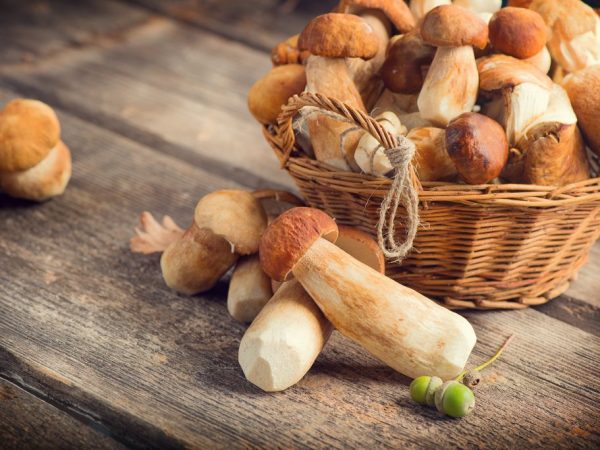
Wood flywheel grows in North America and Europe
Characteristics of the species:
- Hat: has the shape of a hemisphere, diameter - 2-8 cm. The surface is smooth, red-brown, the skin is not removed from the surface of the cap.
- Pulp: dense, yellowish, tasteless and odorless.
- Hymenophore: the tubular layer passes to the leg, its shade is red-brown or rusty-brown. The pores are round or angular in shape, their length is 5-10 mm. Spores are fusiform or elliptical, yellow-olive.
- Leg: thick, 10-27 mm in diameter, 8-10 cm high, often bent, cylindrical. The color is the same as that of the cap or 1-2 tones lighter.
By the way. In appearance, this species is somewhat reminiscent of semi-golden, but has a darker color with a pronounced brown tone.
Pepper moss
There are other inedible representatives of false flyworms that belong to other species. For example, the pepper flywheel belongs to the genus Chalciporus, not Xerocomus. This flywheel is not poisonous, but it is not used because of its bitterness and pungent taste. In rare cases, it is added to food instead of pepper. Its description:
- Hat: its diameter is 2-7 cm, the surface is smooth, the skin cannot be removed. The color is brown, yellow-brown, red-brown, more often light.
- Pulp: yellow, friable, turns red on the cut, which distinguishes these false mushrooms from the real ones.
- Hymenophore: tubules are yellow-brown or brownish-brown, descend to the stem, the pores have an irregular angular shape.
- Leg: 3-8 cm in length and 0.5-3 cm in thickness, often curved, resembles a curved cylinder, its shade is the same as that of the cap or slightly darker.
Hot pepper flywheel is a common species. It is found throughout Europe, Siberia, the Urals and the Caucasus. He was even found on the island of Tasmania.
Summarizing
When in doubt as to whether an edible species has been found, it is best not to harvest it.Mushroom pickers do not recommend taking species of parasitic flywheel and even semi-golden flywheel. It is better to collect green, velvet, motley and other similar varieties. If you are not confident in yourself, it is better to ask a more experienced person to show you good mushrooms.



